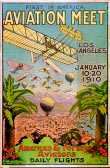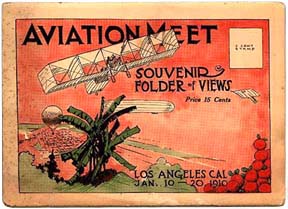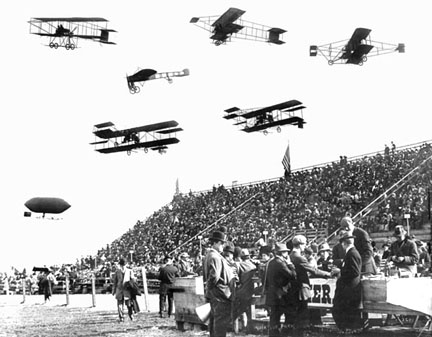
Because of the International Air Meet of 1909 in Reims, France, enthusiasm for aviation began to grow in the United States. At an aviation meet in St Louis, a group of enthusiasts and pilots discussed the feasibility of holding an airmeet in Los Angeles. The group, which included Charles Willard, Roy Knabenshue, and Glenn Curtiss, followed through on the idea and sent promoter Dick Ferris to Los Angeles to make preliminary contacts and develop plans for a proposed aerial exhibition.  On arriving in Los Angeles, Ferris met with various contacts and proposed the International Air Meet that would star Louis Paulhan, a renowned French aviator. The idea was readily accepted by backers. The selected location, a large, open, and relatively flat area known as Dominguez Field, was on part of one of the original Spanish land grants, Rancho San Pedro. Traditional weather patterns suggested this site as generally offering the most favorable conditions—which would prove to be not as well as desired.
On arriving in Los Angeles, Ferris met with various contacts and proposed the International Air Meet that would star Louis Paulhan, a renowned French aviator. The idea was readily accepted by backers. The selected location, a large, open, and relatively flat area known as Dominguez Field, was on part of one of the original Spanish land grants, Rancho San Pedro. Traditional weather patterns suggested this site as generally offering the most favorable conditions—which would prove to be not as well as desired.
Publicity was designed, grandstands erected, and an expanded passenger platform was constructed at the Pacific Electric intercity rail transit station located near the air meet site to accommodate the large number of spectators expected to attend the event. Dates for the event were agreed upon. Beginning on January 10, 1910, and lasting for ten days, the air meet would attract a variety of participants and feature not only aeroplanes, but hot-air balloons and dirigibles. Cash prizes would be awarded to those participating in scheduled events, which would include altitude, speed, and endurance competitions. 
L to R: Hillery Beachey, unknown, unknown, Glenn Curtiss, unknown, Louis Paulhan, Charles Willard, Didier Masson, Lincoln Beachey, Roy Knabenshue, Charles Hamilton. During the next ten days, spectators were thrilled by the performances of aviators Paulhan, Curtiss, Willard, and others—Paulhan was the "star attraction" at the air meet. Invited by the organizers to participate, Paulhan brought with him two Blériot monoplanes, two Farman biplanes, and an entourage that included his wife and a black poodle. At the meet he set a new altitude record (4,164'), endurance record (64 miles in 01h:49m:40s), and won a staggering $14,000 in prize money. Glenn Curtiss won two events—fastest speed with a passenger (55 mph) and quickest start (6.4 seconds, covering 98') to take home $6,500. Charlie Willard was credited with the most accurate take-off and landing skills, for which he was awarded $250.  Attendance surpassed all expectations. During the ten-day period of the air meet, an estimated 226,000 spectators converged on Dominguez Field, plus uncounted thousands watched the goings-on from the edge of the field. Gate receipts for the event were more than $137,500—very impressive for those days—and the event was considered a phenomenal success, easing any possible economic drought in the Los Angeles area. The event also appeared in 1911 and 1912 at the same site with similar public success.(— Peter Bergen. Photos courtesy LA Title & Trust Co)  Mrs Dick Ferris and Louis Paulhan
Mrs Dick Ferris and Louis Paulhan
 Charles WIllard in flight
Charles WIllard in flight
|
